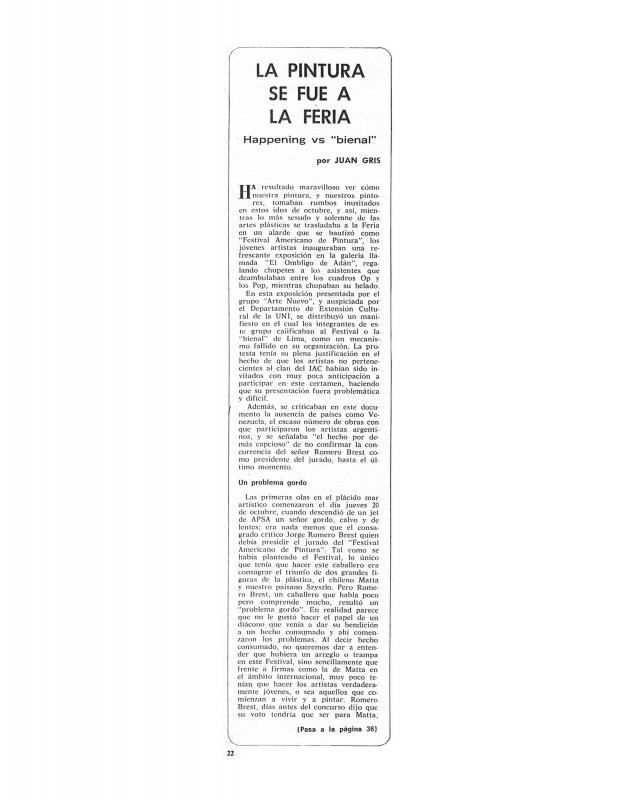This commentary was issued by the art critic Juan Acha on the exhibition by the Peruvian artist Gloria Gómez Sánchez titled Yllomomo. After introducing abstract art to Peru in November of 1965, Gómez Sánchez entered full heartedly into the experimentalist avant-garde phase of her trajectory when she presented the exhibition Yllomomo at the Galería Solisol. It was a collection of works that included framed garbage objects and large muñecones [Peruvian puppets or papet cut-outs] all with marked ephemeral characteristics. Thus, it was a glimpse of her rupture with the established Peruvian traditional artistic styles existent in the artistic circles at the time, a gesture shared by other young artists. The title of the exhibition was quite significant. Yllomomo was the indigenous name of a swamp in Bolivia, where one of its native flowers feed on the waste found beneath the surface of the water. Between October and November of 1966 the Festival Americano de Pintura was held in Lima. Its international jury awarded the first prize to the Chilean artist Roberto Matta, despite the voting going against the president of the jury, the Argentinean Jorge Romero Brest. This fact, as well as the fact of having excluded a group of young avant-garde artists from the award ceremony generated an immediate controversy. The following artists after previously being members of the group Grupo Señal collectively formed a new group called Arte Nuevo: Luis Arias Vera (b. 1931), Gloria Gómez-Sánchez (1921–2007), Teresa Burga (b. 1935), Jaime Dávila (b. 1937), Víctor Delfín (b. 1927), Emilio Hernández Saavedra (b. 1940), José Tang (1941–2006), Armando Varela (b. 1933) and Luis Zevallos Hetzel (b. 1933). Initially, they exhibited their works in an abandoned store that consisted of neon signs located in the historic center of Lima, just a few meters from the Plaza Mayor and from the Palacio de Gobierno, transforming it into an improvised gallery that they named El Ombligo de Adán. This exhibition, with a larger display of Pop Art, Op art and large scale environments was the key to the development of new artistic tendencies in Peru, especially in direct confrontation with the so-called “traditional” art. [Please refer to the ICAA digital archive and the following texts regarding the group Arte Nuevo: “De cómo el Gral. Velasco reventó el ‘¡Pop! Art” by Luis Freire (doc. no. 1139323); “Espíritu renovador: exposición del Grupo “Arte Nuevo” by Juan Acha (doc. no. 1142771); “Exagerado sentido realista: Exposición de Luis Arias Vera” (no author) (doc. no. 1142510); “La nueva imagen del IAC” (doc. no. 1142594) and “La pintura se fue a la feria: Happening vs ‘bienal” (doc. no. 1142737) both Mário Belaúnde Guinassi who goes by the pseudonym Juan Gris; “Mala noche de Buendía” by Felipe Buendía (doc. no. 1142628">1142628); (untitled) [“Nos encontramos en un mundo determinado...”] by the group Arte Nuevo (doc. no. 1142628">1142628); “Grupo Arte Nuevo” (no author) (doc. no. 1142834); “Op-Pop-Sex” (no author) (doc. no. 1142804); “Resentido social” by Felipe Buendía (doc. no. 1142644); “Treinta minutos de charla con la señora Gloria Benvenuto de Gómez Sánchez, nuevo valor de la Pintura Nacional” (no author) (doc. no. 1142413)]. In the mid nineteen sixties, the Peruvian art critic Juan Acha (1916–95), who was based in Mexico, was one of the mayor proponents of the artistic avant-garde movements in Peru. Through his writings, essays and journalistic commentaries, young artists framed by the developmental ideology of the moment and cultivating these tendencies, found a theoretical champion and promotor of both Pop Art and Op Art.










